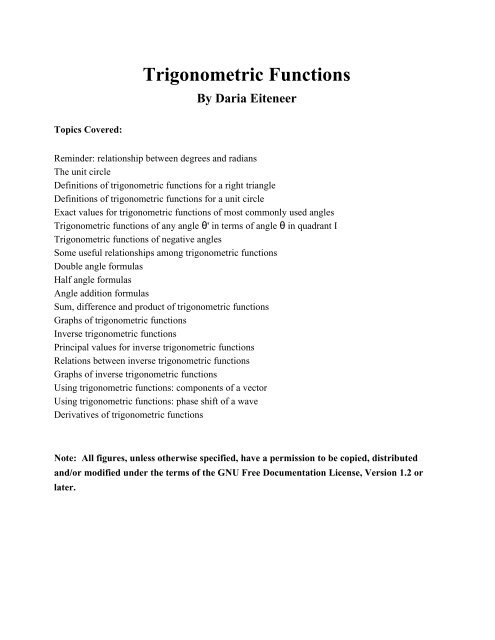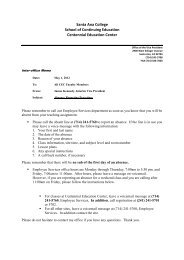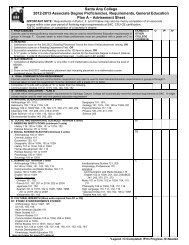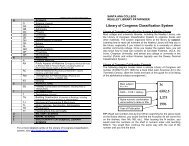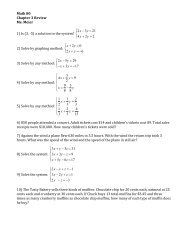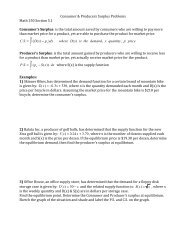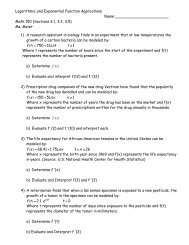Trigonometric Functions
Trigonometric Functions
Trigonometric Functions
Create successful ePaper yourself
Turn your PDF publications into a flip-book with our unique Google optimized e-Paper software.
<strong>Trigonometric</strong> <strong>Functions</strong>By Daria EiteneerTopics Covered:Reminder: relationship between degrees and radiansThe unit circleDefinitions of trigonometric functions for a right triangleDefinitions of trigonometric functions for a unit circleExact values for trigonometric functions of most commonly used angles<strong>Trigonometric</strong> functions of any angle θ' in terms of angle θ in quadrant I<strong>Trigonometric</strong> functions of negative anglesSome useful relationships among trigonometric functionsDouble angle formulasHalf angle formulasAngle addition formulasSum, difference and product of trigonometric functionsGraphs of trigonometric functionsInverse trigonometric functionsPrincipal values for inverse trigonometric functionsRelations between inverse trigonometric functionsGraphs of inverse trigonometric functionsUsing trigonometric functions: components of a vectorUsing trigonometric functions: phase shift of a waveDerivatives of trigonometric functionsNote: All figures, unless otherwise specified, have a permission to be copied, distributedand/or modified under the terms of the GNU Free Documentation License, Version 1.2 orlater.
Reminder: Relationship Between Degrees and RadiansA radian is defined as an angle θ subtended at the center of a circle for which the arc length isequal to the radius of that circle (see Fig.1).Fig.1. Definition of a radian.The circumference of the circle is equal to 2πR, where R is the radius of the circle. Consequently,360°=2 π radians. Thus,1 radian=360°/2 π ≈ 57.296°1° = (2 π /360) radians ≈ 0.01745 radiansThe Unit CircleIn mathematics, a unit circle is defined as a circle with a radius of 1. Often, especially inapplications to trigonometry, the unit circle is centered at the origin (0,0) in the coordinate plane.The equation of the unit circle in the coordinate plane isx 2 + y 2 = 1.As mentioned above, the unit circle is taken to be 360°, or 2 π radians. We can divide thecoordinate plane, and therefore, the unit circle, into 4 quadrants. The first quadrant is defined interms of coordinates by x>0, y>0, or, in terms of angles, by 0°< θ
<strong>Trigonometric</strong> <strong>Functions</strong>Definitions of <strong>Trigonometric</strong> <strong>Functions</strong> For a Right TriangleA right triangle is a triangle with a right angle (90°) (See Fig.2).Fig.2. Right triangle.For every angle θ in the triangle, there is the side of the triangle adjacent to it (from here ondenoted as “adj”), the side opposite of it (from here on denoted as “opp”), and the hypotenuse(from here on denoted as “hyp”), which is the longest side of the triangle located opposite of theright angle. For angle θ, the trigonometric functions are defined as follows:oppsine of θ = sin θ =hypadjcosine of θ = cos θ =hyptangent of θ = tan θ =cotangent of θ = cot θ =secant of θ = sec θ =cosecant of θ = csc θ =sinθcosθ = oppadj1tanθ = cosθsinθ = adjopp1cosθ = hypadj1sinθ = hypopp
Definitions of <strong>Trigonometric</strong> <strong>Functions</strong> For a Unit CircleIn the unit circle, one can define the trigonometric functions cosine and sine as follows. If (x,y) isa point on the unit cirlce, and if the ray from the origin (0,0) to that point (x,y) makes an angle θwith the positive x-axis, (such that the counterclockwise direction is considered positive), then,cos θ = x/1 = xsin θ = y/1 = yThen, each point (x,y) on the unit circle can be written as (cos θ, sin θ). Combined with theequation x 2 + y 2 = 1, the definitions above give the relationship sin 2 θ+cos2 θ=1. In addition, othertrigonometric functions can be defined in terms of x and y:tan θ = sin θ/cos θ = y/xcot θ = cos θ/sin θ = x/ysec θ = 1/cos θ = 1/xcsc θ = 1/ sin θ = 1/yFig.3 below shows a unit circle in the coordinate plane, together with some useful values of angleθ, and the points (x,y)=(cos θ, sin θ), that are most commonly used (also see table in the followingsection).Fig.3. Most commonly used angles and points of the unit circle.Note: For θ in quadrant I, sinθ>0, cos θ >0; for θ in quadrant II, sin θ>0, cos θ
Exact Values for <strong>Trigonometric</strong> <strong>Functions</strong> of Most Commonly Used Anglesθ in degrees θ in radians sinθ cosθ tanθ0 0 0 1 030π612323345π42222160π 3 13 2 2390π21 0 undefined180 π 0 -1 02703 π2-1 0 undefined360 2π 0 1 0Note: Exact values for other trigonometric functions (such as cotθ, secθ, and cscθ) as well astrigonometric functions of many other angles can be derived by using the following sections.<strong>Trigonometric</strong> <strong>Functions</strong> of Any Angle θ' in Terms of Angle θ in Quadrant Iθ' sinθ' cosθ' tanθ' θ' sinθ' cosθ' tanθ'90°+θπ/2+θcosθ -sinθ cotθ90°-θπ/2θcosθ sinθ cotθ180°+θπ+θsinθ cosθ tanθ180°-θπ-θsinθ cosθ tanθ270°+θ3π/2+θcosθ sinθ cotθ270°-θ3π/2θcosθ sinθ cotθk(360°)+θk(360°)-θk(2π)+θsinθ cosθ tanθk(2π)-θsinθ cosθ tanθk=integerk=integer
<strong>Trigonometric</strong> <strong>Functions</strong> of Negative Anglessin(- θ) = -sinθcos(- θ) = cosθtan(- θ) = -tanθSome Useful Relationships Among <strong>Trigonometric</strong> <strong>Functions</strong>sin 2 θ + cos2 θ = 1sec 2 θ – tan2 θ = 1csc 2 θ – cot2 θ = 1Double Angle Formulassin2 θ = 2 sin θ cosθcos2 θ = cos 2θ – sin 2 θ = 1-2 sin 2 θ = 2 cos 2 θ -1tanθtan2θ = 21−tan 2 θHalf Angle FormulasNote: in the formulas in this section, the “+” sign is used in the quadrants where the respectivetrigonometric function is positive for angle θ/2, and the “-” sign is used in the quadrants where therespective trigonometric function is negative for angle θ/2.sin θ 2 = ± 1−cosθ2cosθ2 = ± 1cosθ2tan θ 2 = ± 1−cosθ1cosθ = sinθ1cosθ = 1−cosθsinθ
Angle Addition FormulasNote: in this and the following section, letters A and B are used to denote the angles of interest,instead of the letter θ.sin A±B = sinAcosB ± cosA sinBcos A± B = cosA cos B∓sinA sinBtanA± tanBtan A± B =1∓tanAtanBcot(A±B)=cotAcotB∓1cotB ± cotASum, Difference and Product of <strong>Trigonometric</strong> <strong>Functions</strong>sinA + sinB = 2sin AB2sinA – sinB = 2sin A−B2cosA + cosB = 2 cos AB2cosA – cosB = −2sin AB2cos A−B 2cos AB 2cos A−B 2sin A−B 2sinA sinB =cosA cosB =sinA cosB =1 [cos A−B−cos AB]21 [cos A−Bcos AB]21 [sin A−Bsin AB]2
Graphs of <strong>Trigonometric</strong> <strong>Functions</strong> (Fig.4, a-f)Note: In each graph in Fig.4, the horizontal axis (x) is measured in radians.Ref. Weisstein, Eric W. “Sine.” “Cosine.” “Tangent.” “Cotangent.” “Secant.” “Cosecant.” FromMathWorld – A Wolfram Web Resource: http://mathworld.worlfram.comFig.4a. Graph of sin(x).Fig.4b. Graph of cos(x).Fig.4c. Graph of tan(x).Fig.4d. Graph of cot(x).Fig.4e. Graph of sec(x).Fig.4f. Graph of csc(x).
Inverse <strong>Trigonometric</strong> <strong>Functions</strong>Inverse <strong>Trigonometric</strong> <strong>Functions</strong>If x=sin(y), then y=sin -1 (x), i.e. s is the angle whose sine is y. In other words, x is the inverse sineof y. Another name for inverse sine is arcsine, and the notation used is y=arcsin(x). Similarly, wecan define inverse cosine, inverse tangent, inverse cotangent, inverse secant and inverse cosecant.All of the inverse functions are many-valued functions of x (for each value of x, there are manycorresponding values of y), which are collections of single-valued functions (for each value of x,there is only one corresponding value of y) called branches. For many purposes a particularbranch is required. This is called the principal branch and the values for this branch are calledprincipal values.x = sin(y)y = sin 1 (x) = arcsin(x)x = cos(y) y = cos 1 (x) = arccos(x)x = tan(y)x = cot(y)y = tan 1 (x) = arctan(x)y = cot 1 (x) = arccot(x)x = sec(y) y = sec 1 (x) = arcsec(x)x = csc(y) y = csc 1 (x) = arccsc(x)Principal Values for Inverse <strong>Trigonometric</strong> <strong>Functions</strong>Principal Values forx00sin −1 xπ/20cos −1 xπ/20tan −1 xπ/20cot −1 xπ/20sec −1 xπ/20csc −1 xπ/2Principal Values forx0−π/2sin −1 x0π/2cos −1 xπ−π/2tan −1 x0π/2cot −1 xππ/2sec −1 xπ−π/2csc −1 x0
Relations Between Inverse <strong>Trigonometric</strong> <strong>Functions</strong>Note: In all cases, it is assumed that principal values are used.sin -1 x + cos -1 x = π/2tan -1 x + cot -1 x = π/2sec -1 x +csc -1 x = π/2csc -1 x = sin -1 (1/x)sec -1 x = cos -1 (1/x)cot -1 x = tan -1 (1/x)sin -1 (-x) = -sin -1 xcos -1 (-x) = π - cos-1 xtan -1 (-x) = -tan -1 xcot -1 (-x) = π – cot-1 xsec -1 (-x) = π – sec-1 xcsc -1 (-x) = -csc -1 xGraphs of Inverse <strong>Trigonometric</strong> <strong>Functions</strong> (Fig.5, a-f)Note: In each graph in Fig.5, the vertical axis (y) is measured in radians. Only portions of curvescorresponding to principal values are shown.Ref. Weisstein, Eric W. “Inverse Sine.” “Inverse Cosine.” “Inverse Tangent.” “InverseCotangent.” “Inverse Secant.” “Inverse Cosecant.” From MathWorld – A Wolfram WebResource: http://mathworld.worlfram.comFig.5a. Graph of sin -1 (x).Fig.5b. Graph of cos -1 (x).
Fig.5c. Graph of tan -1 (x).Fig.5d. Graph of cot -1 (x).Fig.5e. Graph of sec -1 (x).Fig.5f. Graph of csc -1 (x).
Using <strong>Trigonometric</strong> <strong>Functions</strong>Resolving Vectors into Components:The geometric way of adding vectors is not recommended whenever great accuracy is required orin three-dimensional problems. In such cases, it is better to make use of the projections of vectorsalong coordinate axis, also known as components of the vector. Any vector can be completelydescribed by its components.Consider an arbitrary vector A (from now on, the bold-cased letters are used to signify vectors,whereas the regular-font letter A signifies the length of the vector A) lying in the xy-plane andmaking an arbitrary angle θ with the positive x-axis, as shown in Fig.6:Fig.6. Arbitrary vector A in the xy-plane.This vector A can be expressed as the sum of two other vectors, A x and A y . From Fig.6, it can beseen that the three vectors form a right triangle and that A=A x +A y . It is conventional to refer to the“components of vector A,” written A x and A y (without the boldface notation). The component A xrepresents the projection of A along the x-axis, and the component A y represents the projection ofA along the y-axis. These components can be positive or negative.From Fig.6 and the definition of sine and cosine for a right triangle, we see that cos θ=Ax/A andsin θ=Ay/A. Hence, the components of A are
A x =A cosθA y =A sinθThese components from the two sides of a right triangle with hypotenuse of length A. Thus, itfollows that the magnitude and direction of A are related to its components through theexpressionsA= Ax 2 Ay 2θ=tan −1 AyAx Note that the signs of the comonents A x and A y depend on the angle θ. For example, if θ =120°,then A x is negative and A y is positive.When solving problems, one can specify a vector A either with its components Ax and Ay or withits magnitude and direction A and θ. Furthermore, one can express a vector A asA=Ax xAy y=Acosθ xsinθ y ,where x and y are unit vectors (length of one) in the direction of x- and y-axis, respectively.Writing a Phase Shift of a WaveWaves can have many different shape. One of the simplest to deal with and also one that is of aparticular interest when it comes to simple harmonic motion is a sinusoidal wave. It is called“sinusoidal” because the shape that the wave takes either in space or in time is that of a sine curve(see Fig.7a,b):Fig.7.(a) A one-dimensional sinusoidal wave in space.Fig.7b. A one-dimensional sinusoidal wave in time.
A function describing such a wave can be written asy=Asin 2 πλx± 2 πT tφ ,where A is the amplitude of the wave, λ is the wavelength of the wave, T is the period of the wave,and φ is the phase shift of the wave. The ± sign in front of the second term in the parenthesesdepends on whether the wave is moving to the right (-) or to the left (+). The entire expression inthe parentheses can also be written as Φ(x,t) and is called the total phase of the wave, and is afunction of position x and time t, in contrast to the phase shift φ , which is a constant. Then, theentire expression becomes y = A sin Φ(x,t).Because the sine function is periodic with period 2 π, sin( Φ+2πn)=sin( Φ) for any integer n.φ is referred to as a phase-shift, because it represents a "shift" from zero phase. But a change in φis also referred to as a phase-shift. Fig.8 shows two curves: the red one with zero phase, and theblue one with a non-zero phase.Fig.8. Phase shift.Two oscillators that have the same frequency and same wavelength, will have a phase difference,if their phase shift φ is different. If that is the case, the oscillators are said to be out of phase witheach other. The amount by which such oscillators are out of phase with each other can beexpressed in degrees from 0° to 360°, or in radians from 0 to 2 π (see Fig.9a,b).Fig.9a. Waves that are in phase.Fig.9b. Waves that are out of phase.
Derivatives of <strong>Trigonometric</strong> and Inverse <strong>Trigonometric</strong> <strong>Functions</strong>dsin x=cos xdxdcos x=−sin xdxddx tan x=sec2 xddx cot x=−csc2 xdsec x=sec x tan xdxdcsc x=−csc x cot xdxddx sin−1 x= 1 −π,1−x 2 2 sin−1 x π 2ddx cos−1 x=−1, 0cos −1 xπ1−x 2ddx tan−1 x= 1 −π,1x 2 2 tan−1 x π 2ddx cot−1 x= −1 , 0cot −1 xπ1x 2ddx sec−1 x= ±1x x 2 −1 , + if 0sec −1 x π 2 , - if π2 sec−1 xπddx csc−1 x=∓1x x 2 −1 , - if 0csc −1 x π 2 , + if −π2 csc−1 x0


